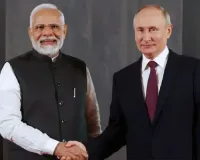US President Trump announces additional 27 per cent tariffs on India

The US has announced additional 27 per cent import duties on India saying New Delhi imposes high tariffs on American goods, as the Donald Trump administration aims to reduce the trade deficit and boost manufacturing.
Though the move is expected to impact India's exports of certain sectors to the US, experts say that India is better-placed than its competitors, including Bangladesh (37 per cent), China (54 per cent), Vietnam (46 per cent) and Thailand (36 per cent) who face increased levies.
President Trump, in a historic measure to counter higher duties on American products imposed globally, announced reciprocal tariffs on about 60 countries.
"This is Liberation Day, a long-awaited moment. April 2, 2025 will forever be remembered as the day American industry was reborn, the day America's destiny was reclaimed, and the day that we began to make America wealthy again. We are going to make it wealthy, good, and wealthy," Trump said in his remarks from the Rose Garden at the White House on Wednesday.
He said that the United States charges other countries only a 2.4 per cent tariff on motorcycles, but Thailand and others are charging much higher rates, like 60 per cent, India 70 per cent, Vietnam 75 per cent, and others charge even higher rates.
As he announced the tariffs, he held up a chart that showed the tariffs that countries such as India, China, the UK, and the European Union charge, along with the reciprocal tariffs that these countries will now have to pay.
The chart indicated that India charged an average 52 per cent tariffs, including currency manipulation and trade barriers on US goods, and America would now charge India a 'discounted' reciprocal tariff of 26 per cent. But according to the White House documents, there will be a 27 per cent additional duty on India.
"India, very, very tough. Very, very tough. The prime minister just left. He's a great friend of mine, but I said, you're a friend of mine, but you're not treating us right. They charge us 52 per cent. You have to understand, we charge them almost nothing for years and years and decades, and it was only seven years ago, when I came in, that we started with China," Trump said.
Goods from India are already facing a 25 per cent tariff on steel, aluminium, and auto. For remaining products, India is subject to a base line tariff of 10 per cent between April 5-8. After that, the tariff will rise to country-specific 27 per cent starting April 9.
Explaining the imposition of the additional duty, an official said if product 'A' faces 5 per cent duty in America at present, it will be 15 per cent on April 5 and 32 per cent from April 9.
The official said that these tariffs were a "mixed bag and not a set back" and the commerce ministry is analysing the impact of this reciprocal tariff.
"The ministry is analysing the impact of the announced tariffs. India's position remains comparatively more favourable than that of its competitor nations even after imposition of these duties in labour intensive sectors like textiles," the official said, adding, there is a provision that if a country would address the concerns of the US, the Trump administration can consider reducing the duties against that nation.
Goods in transit would not be subjected to these duties, the official clarified.
India is already negotiating a bilateral trade agreement with the US.
The two countries are aiming to finalise the first phase of the pact by fall (September-October) of this year and targeting USD 500 billion bilateral trade by 2030 from USD 191 billion at present.
Apex exporters body Federation of Indian Export Organisations (FIEO) said the duties pose challenges for domestic players but India is better placed as its competitor nations as their goods would face much more sweeping taxes.
FIEO President S C Ralhan said certain sectors, including apparel, gems and jewellery, leather, electronics, chemicals, plastics, and furniture, may experience a diversion of exports, potentially offsetting some adverse effects.
He added that early conclusion of the proposed bilateral trade agreement would help dilute the impact of these taxes.
Gems and jewellery exporters have stated that the tariffs are a "major setback" for the Indian gems and jewellery exports and urged the government to take steps to secure the long-term interest of the sector.
"It's a big setback for India as the US has announced retaliatory tariffs. The gems and jewellery sector will be the most affected as import tariffs may be up to 20 per cent from the current zero per cent on loose diamonds and 5.5-7 per cent on gold jewellery," Colin Shah, MD of Kama Jewelry, said.
The US is one of India's largest jewellery export markets, accounting for almost 30 per cent of the share. Indian jewelry exports to the US are over USD 11 billion per year.
Steel industry stated that India will become more vulnerable to low-cost steel imports as countries impacted by the US' tariff move may divert their shipments to the domestic market.
Association of Indian Medical Device Industry (AiMeD) said that the sector exports may pose challenges to the sector's growth due to the additional taxes.
From 2021-22 to 2023-24, the US was India's largest trading partner. The US accounts for about 18 per cent of India's total goods exports, 6.22 per cent in imports, and 10.73 per cent in bilateral trade.
With America, India had a trade surplus (the difference between imports and exports) of USD 35.32 billion in goods in 2023-24. This was USD 27.7 billion in 2022-23, USD 32.85 billion in 2021-22, USD 22.73 billion in 2020-21, and USD 17.26 billion in 2019-20.
In 2024, India's main exports to the US included drug formulations and biologicals (USD 8.1 billion), telecom instruments (USD 6.5 billion), precious and semi-precious stones (USD 5.3 billion), petroleum products (USD 4.1 billion), gold and other precious metal jewellery (USD 3.2 billion), ready-made garments of cotton, including accessories (USD 2.8 billion), and products of iron and steel (USD 2.7 billion).
Imports included crude oil (USD 4.5 billion), petroleum products (USD 3.6 billion), coal, coke (USD 3.4 billion), cut and polished diamonds (USD 2.6 billion), electric machinery (USD 1.4 billion), aircraft, spacecraft and parts (USD 1.3 billion), and gold (USD 1.3 billion).









